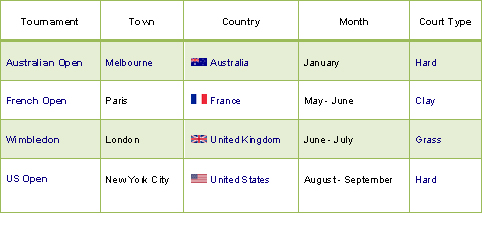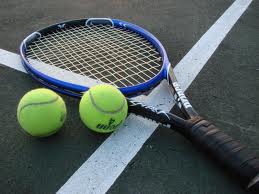 |
Tennis is a sport usually played between two players (singles) or between two teams of two players each (doubles). Each player uses a racket that is strung to strike a hollow rubber ball covered with felt over a net into the opponent's court. Tennis is an Olympic sport and is played at all levels of society at all ages. The sport can be played by anyone who can hold a racket, including people in wheelchairs. . |
History Of Tennis
While the modern game of tennis originated in late 19th century England, most historians believe that the games ancient origin is from 12th century France, but the ball was then struck with the palm of the hand. It was not until the 16th century that rackets came into use, and the game began to be called "tennis", from the Old French term Tenez, which can be translated as "hold!", "receive!" or "take!". An interjection used as a call from the server to his opponent. It was popular in England and France, although the game was only played indoors where the ball could be hit off the wall. Henry VIII of England was a big fan of this game, which is now known as real tennis. During the 18th century and early 19th century, as real tennis declined, new racquets sports emerged in England. Between 1859 and 1865 Harry Gem and his friend Augurio Perera developed a game that combined elements of rackets and the Basque ball game pelota, which they played on Perera's croquet lawn in Birmingham, United Kingdom. In 1872, along with two local doctors, they founded the world's first tennis club in Leamington Spa. Top
Rules and Regulations of Tennis
The rules and regulations of tennis extend from court rules all the way to the tennis rules of the game during play. Below is a relatively cropped-up list of tennis rules and regulations, some general and some game related. We will not go into the details of the rules governing the tennis court dimensions, the fixtures on court and the sizes and lengths of various things. We will just get to business and see the rules that you should know as a tennis player. Tennis Gear As with most sports, when playing professional tennis, the tennis players are expected to wear proper tennis shoes. This rule was made to protect the tennis court from blemishes and tread marks. Read more on tennis equipment. Tennis Rackets A tennis racket is only legal if it has all the stitches attached and unbroken, does not have any energy source attached that can affect the play and does not have more than one set of stringed patterns on it. Vibration dampening devices are only allowed if they are placed outside the criss-crossed string pattern. Service or Court The player that wins the toss is expected to choose either the side from where he prefers playing or the serve. If the toss winner chooses to serve, the other player automatically gets the choice of court side. When a server is serving in a game, the receiver is allowed to stand outside the court lines if he wishes to do so. The players are supposed to change court sides on the completion of every odd game, i.e. the first, third, etc. Service All serves that fall in the opponent's service box and are served from behind the out-of-bounds lines are counted as good serves. In lawn tennis, a server is allowed to make underhanded serves. The service can only be counted as legal when the opponent is ready to receive it. The server loses the point if he makes a double fault on his serve (that is, he cannot get a good serve despite having two chances to do so). Continuous Play The game of tennis once started must be in continuous play till the match ends. Twenty seconds are allowed between points and ninety seconds are given for players to change ends at the end of a game. At the conclusion of each set, a maximum of 120 seconds are given to the players. Scoring In a standard game of tennis, the scores are called out keeping the server's scores first. When both players are on zero, it is termed as a 'love all' start. Having no points are referred to as 'love' while the first, second, third and fourth points are called out as '15', '30' '40' and 'Game' respectively. When both the players have won three points, the score is termed as a 'Deuce' and a deuce extends the game by one additional point. That is, after a deuce comes 'Advantage' (awarded to whichever player wins the points) and after advantage comes 'Game'. An advantage game reverts back to deuce if the player fails top convert his advantage into a game. In other words, a player must win two consecutive points after a deuce to win a game. Read more on the tennis scoring system. Top
Main Tournaments or Grand Slams
Latest Single Palyers ATP Rankings
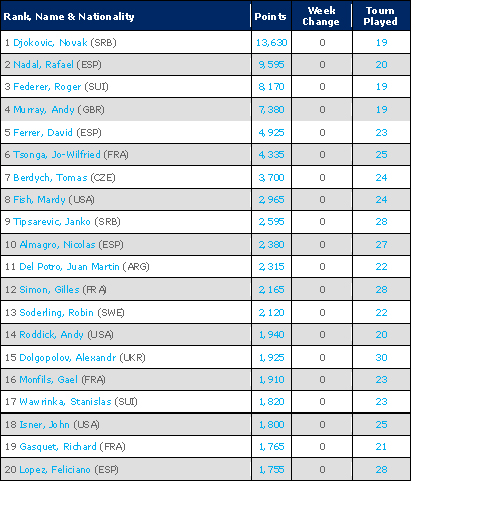
Latest Double Players ATP Rankings
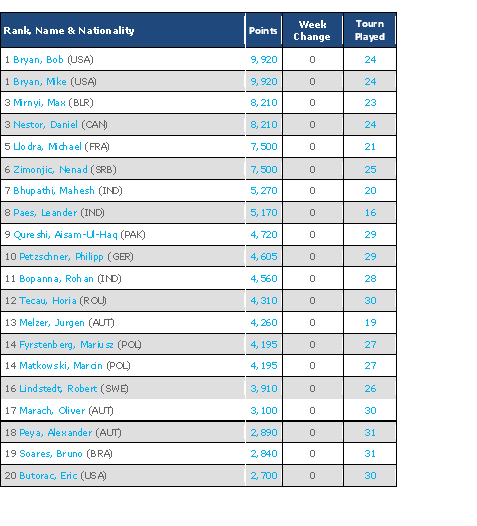
Top Tennis Players
 |
 |
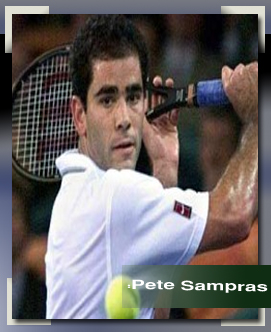 |
|||
 |
 |
